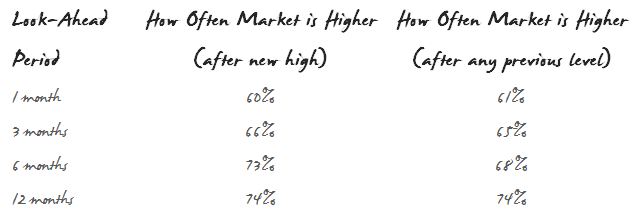Since its March 2009 low, the U.S. stock market has surged to record levels. The widely-cited Dow Jones Industrial Average has increased almost 175%, crossing the 18,000 mark yesterday. Meanwhile the Standard & Poor’s 500 Index of large company stocks has surged nearly 210%, recently hitting 2,080, its highest level ever.
The financial media loves market milestones such as these. They get people talking about whether the fresh high is a sign of more to come or a signal of a dangerous market headed for a fall. Experts weigh in, viewers tune in and magazines fly off the shelves.
But does a new market high tell us anything about where the market is headed?
To answer the question, we examined all new market highs over the past 50 years. From those points in time, we looked forward 1, 3, 6 and 12 months to evaluate how markets perform after reaching a new record.
We found, on average, the market was higher 60% of the time one month after a new high. Three months later, the market was higher 66% of the time. Six months later, the market was higher 73% of the time and twelve months later, the market was higher about 74% of the time.
These results shouldn’t come as a surprise. Over time, companies produce higher profits, economies grow and stock prices rise. These higher profits and prices push stock markets to higher and higher levels. So, even after a market high, we should expect markets to continue to rise more often than not. (This is not to suggest we shouldn’t always be prepared for market turbulence.)
Still, these initial findings answer only part of our earlier question. Remember, we examined subsequent price levels after only a new high. What we really want to know is if these market highs—as compared to any other day chosen at random—suggest where stocks might be headed.
To determine this, we need to examine the market’s future path not just after a record high, but after each and every day.
The table below summarizes our findings:

From this table we can conclude two things: First, markets go up over time. This can be seen by comparing the greater frequency of higher price levels as time passes. Second, a market high is no more useful in predicting the market’s future direction than is any other day.
Rather than signal what’s in store for markets, a new market high should serve as a reminder of the reward for focusing on what matters: Developing, and adhering to, an appropriate asset allocation—regardless of where the market is today.
